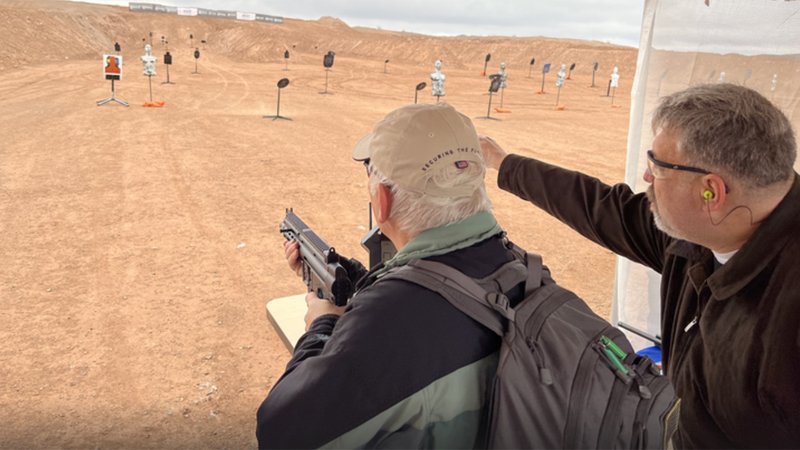IDF leverages new target technology for small arms training
Romtes Technologies is looking beyond the ongoing expansion of its Short Circuit Target (SCT) system across Israel Defense Forces (IDF) small arms training.
Romtes’ recent participation in the SHOT Show, held in Las Vegas in late January, provided the author with a chance to conduct live fire exploration with the system... Continues below
Newsletter Sponsor:

Above: Shephard’s Scott R Gourley tries out the Romtes SCT system on the SHOT Show range last month. (Photo: author)
The portable system utilises wireless communication between a transmitter on a target stand and a receiver at the shooting position, which can be up to 1,600 yards (1,463m) away.
Targets placed on the stand consist of several layers of materiel, two of which are conductive. When a round penetrates the target, it creates a short-circuit between those layers. The location of that short-circuit is detected and transmitted back to the receiver at the shooter’s position, identifying the specific zone that was hit.
According to Natanel Tessel, CEO of Romtes, the system, which was previously used in the training of some special operations forces, is now expanding across the IDF.

Providing mission-critical training and equipment, this elevated level of innovation can only be provided by the best in the industry. Visit FlightSafety.com.
‘Every IDF infantry soldier now recruited is going to use this system to be trained,’ Tessel said. ‘That's going to save them a lot of time in training, since there is no need to go back and forth to the target to get the feedback. It helps them to level up the training because they get instant feedback.
‘You know where you hit. You get corrected on spot. And it's very easy and lightweight, so you can put it everywhere. You can shoot any type of round: pistol; heavy rifles; whatever you need, any calibre any distance.’
He continued: ‘It fits [unit training] for the platoon commander, for the brigade, for any size of training group. We have military users worldwide. It also works well for law enforcement training. We have Israeli police, and every state police station could have this, so they don't need to go to the large training facility. They go to the local range and they train the same… because they have the same systems.’
Other articles in this newsletter:
New rules – how the US Marine Corps is taking wargaming to the next level
Why rethinking training is vital for the USMC’s new force design
The company is looking to expand the system into new military markets, as evidenced by its presence alongside American Tactical on the SHOT Show range.
Kevin Stasik, sales and support representative for American Tactical, confirmed the partnership and distribution arrangement with Romtes.
Tessel noted: ‘We also have multiple types of target silhouettes from tactical centre mass, to head shot, to zeroing targets, to many types of silhouettes.’
Referring to the system’s durability he added: ‘On a range, shooting 5.56mm or .223 caliber, you can feasibly get anywhere between 800 and 1,000 rounds for a single target. And it runs straight and true every single time in all weather conditions.’
Target options provide between two and eight 'scoring zones'. For SHOT Show range day and Shephard’s live fire experience, the companies had pre-positioned a five-zone target (with alphabetical A-F labels) that was wirelessly linked to a large-screen tablet located next to our firing position. The day featured passing rain showers, which helped to illustrate some of the outdoor durability aspects.
After the briefest of instructions, Stasik served as 'spotter', monitoring the tablet and immediately calling the zone hit location of individual shots. While it felt like the spotter would be the optimum addition to the training experience, the technology could theoretically allow the individual shooter to monitor their own hit locations and subsequent progress.
Don't want to miss out on future Decisive Edge content? Make sure you are signed up to our email newsletters.











